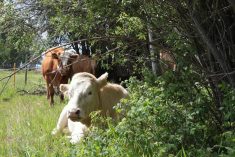A comprehensive survey was completed by Dr. Cheryl Waldner at the Western Veterinary College in Saskatoon looking at the incidence of early calfhood diseases across Western Canada. Surveys were distributed to veterinary clinics across this region and randomly distributed to their clients. Thanks to the participating veterinarians and their clients who responded and answered the questionnaire completely and honestly.
This area had not been looked at for some time and with the ever-changing dynamics of the cow-calf sector across Western Canada some interesting results were obtained. I will touch on some of the more significant points which came out of the survey and which should benefit the cow-calf producer.
Read Also

Mosquito-borne virus could be devastating to sheep breeding operations
Cache Valley virus, a mosquito-borne disease that infects small ruminants, could be a devastating hit to small operations.
It is no surprise the average number of cows per herd has increased over the years. It is now approximately 200 head, which with greater numbers calving inherently brings with it more problems than with smaller herds. A fairly high percentage — 14 per cent of herds — treated greater than 10 per cent of their calves for scours. Around five per cent of the herds had problems with scours. This illustrates the adage that once you have one case it is likely to have several. The key is to prevent the first case from developing or isolate it and prevent further spread.
One of the key components against developing scours is boosting the calve’s immunity through the colostrum. Improving the cow’s colostrum is accomplished through good nutrition and vaccinating, especially for scours. If you are worried that calves did not receive adequate colostrum, it should be supplemented with a good-quality colostrum substitute.
Since there are very good broad-spectrum scours vaccines which have proven beneficial, I was shocked to find how few producers vaccinate. If we include vaccinating in the fall or pre-calving, only about 40 per cent of producers vaccinate. This to me is quite low which is one reason why many calves are still treated for scours.
This is evident to me by the amount of electrolytes clinics sell in the spring. I personally would rather try to prevent than treat. Farmers still regarded diarrhea (whether scours or coccidiosis) as the most important disease they treat in half the herds. Many questions come up every year about coccidiosis at producer meetings.
Colostrum use higher
It is good to see many producers — 70 per cent — conscientiously using colostrum or colostrum supplements when necessary. Now this may have only been in one calf, but it shows me producers are geared up to administer it and have it on hand. The quality of the commercial colostrum sources like Headstart have really improved over the years and the amount of immunoglobulin is indicated on the label.
Some producers milk out a heavy-producing cow the first time to have colostrum on hand. It should be mentioned that Headstart is colostrum from dairies that do vaccinate for scours, as maximum protection is paramount.
Only a few (1.9 per cent) used homemade recipes, boluses and milk replacers and I would really caution that in these instances producers are not getting the protection they think. There is still much education necessary when it comes to colostrum supplementation but thankfully most producers are getting the message.
The effort of providing colostrum supplementation to twin calves or calves on cows with mastitis or little milk may prevent the first scours case from developing. We all know that protection through the colostrum is key. A little effort here may save lots of treatment headaches later on in the calving season if a scours outbreak is prevented.
Early calving was shown to yield an increased chance of treating for scours, whether from increased stress from cold weather, close proximity to each other or running through a calving barn. Overall the probability increased. Some scours are caused by clostridial organisms so vaccinating with a clostridial vaccine after Jan. 1 greatly decreased the incidence of scours. Also vaccinating with a scours vaccine after Jan. 1 compared to not vaccinating or in the fall lowered the risk of calves dying at less than one month.
The colostral immunity will be high to both these vaccines. In our area boostering the cows with blackleg vaccine every year or two is becoming more and more of an accepted practice. It has many benefits some of which we don’t even know the answers to.
Scours treatment
When looking at the drugs used to treat scours we as veterinarians have generally felt electrolytes are the most important thing followed by antibiotics (usually injectable) and anti-inflammatory drugs. The survey indicates the reverse actually happens — producers with scours are three times as likely to just treat with antibiotics, than electrolytes. Most scours occur between three days or older meaning they are most likely viral in origin so the electrolytes will do them more good.
Another agreed issue with most veterinarians is because the gut is compromised, injectable antibiotic drugs get into the bloodstream are more beneficial than boluses which need to be digested and then absorbed. That is happening because the study reported twice as many calves are treated with injectable antibiotics. Again lots of different concoctions are used including homemade electrolyte solutions. Some have merit, others probably don’t. I always like the commercial electrolyte products, which have been balanced and tested.
The second most recognized neonatal problem was pneumonia followed by navel infection, which I think one would expect. The most common things done to calves at birth are still selenium and vitamin A & D shots. The increase in producers calving later and on pasture is why the percentage of these two procedures by farmers is around 40 per cent.
Long-acting antibiotics are given at birth in around 15 per cent of the calves probably as a protection against navel infection or pneumonia.
This survey should provide a good synopsis on what is going on in the industry and what is accepted practice out in the field. We slowly are getting back to the management levels most of our herds had prior to BSE. I would encourage any of you to take up the management practices recommended by your peers.
Here’s to a healthy and prosperous calving season.















